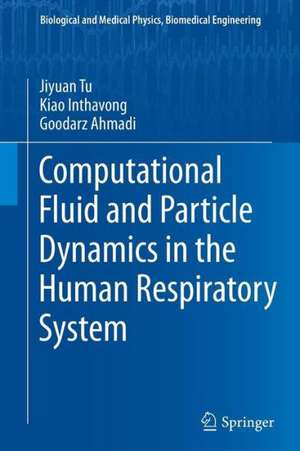Computational Fluid and Particle Dynamics in the Human Respiratory System: Biological and Medical Physics, Biomedical Engineering
Autor Jiyuan Tu, Kiao Inthavong, Goodarz Ahmadien Limba Engleză Paperback – 15 oct 2014
In addition to a brief introduction to the physics of the respiratory system and an overview of computational methods, the book contains best-practice guidelines for establishing high-quality computational models and simulations. Inspiration for new simulations can be gained through innovative case studies as well as hands-on practice using pre-made computational code. Last but not least, students and researchers are presented the latest biomedical research activities, and the computational visualizations will enhance their understanding of physiological functions of the respiratory system.
| Toate formatele și edițiile | Preț | Express |
|---|---|---|
| Paperback (1) | 998.16 lei 6-8 săpt. | |
| SPRINGER NETHERLANDS – 15 oct 2014 | 998.16 lei 6-8 săpt. | |
| Hardback (1) | 1009.85 lei 6-8 săpt. | |
| SPRINGER NETHERLANDS – 18 sep 2012 | 1009.85 lei 6-8 săpt. |
Din seria Biological and Medical Physics, Biomedical Engineering
- 5%
 Preț: 1110.32 lei
Preț: 1110.32 lei - 18%
 Preț: 1006.55 lei
Preț: 1006.55 lei - 18%
 Preț: 960.78 lei
Preț: 960.78 lei - 18%
 Preț: 704.11 lei
Preț: 704.11 lei - 18%
 Preț: 967.40 lei
Preț: 967.40 lei - 18%
 Preț: 948.92 lei
Preț: 948.92 lei - 15%
 Preț: 641.71 lei
Preț: 641.71 lei - 15%
 Preț: 644.95 lei
Preț: 644.95 lei - 15%
 Preț: 665.08 lei
Preț: 665.08 lei - 18%
 Preț: 1669.16 lei
Preț: 1669.16 lei - 18%
 Preț: 941.05 lei
Preț: 941.05 lei - 18%
 Preț: 956.81 lei
Preț: 956.81 lei - 18%
 Preț: 950.21 lei
Preț: 950.21 lei - 15%
 Preț: 636.80 lei
Preț: 636.80 lei - 18%
 Preț: 947.50 lei
Preț: 947.50 lei - 15%
 Preț: 636.80 lei
Preț: 636.80 lei -
 Preț: 397.01 lei
Preț: 397.01 lei - 18%
 Preț: 1236.99 lei
Preț: 1236.99 lei - 15%
 Preț: 644.49 lei
Preț: 644.49 lei - 18%
 Preț: 946.55 lei
Preț: 946.55 lei - 15%
 Preț: 712.22 lei
Preț: 712.22 lei - 18%
 Preț: 952.89 lei
Preț: 952.89 lei - 18%
 Preț: 944.36 lei
Preț: 944.36 lei - 18%
 Preț: 1228.29 lei
Preț: 1228.29 lei - 5%
 Preț: 1422.67 lei
Preț: 1422.67 lei - 18%
 Preț: 1393.27 lei
Preț: 1393.27 lei - 15%
 Preț: 651.19 lei
Preț: 651.19 lei - 18%
 Preț: 953.65 lei
Preț: 953.65 lei - 18%
 Preț: 955.88 lei
Preț: 955.88 lei - 15%
 Preț: 644.95 lei
Preț: 644.95 lei - 5%
 Preț: 1098.48 lei
Preț: 1098.48 lei - 18%
 Preț: 959.19 lei
Preț: 959.19 lei - 15%
 Preț: 643.65 lei
Preț: 643.65 lei - 5%
 Preț: 1159.16 lei
Preț: 1159.16 lei - 5%
 Preț: 1102.67 lei
Preț: 1102.67 lei - 18%
 Preț: 952.09 lei
Preț: 952.09 lei - 18%
 Preț: 946.55 lei
Preț: 946.55 lei - 18%
 Preț: 952.09 lei
Preț: 952.09 lei - 15%
 Preț: 703.20 lei
Preț: 703.20 lei - 18%
 Preț: 953.65 lei
Preț: 953.65 lei - 5%
 Preț: 1008.45 lei
Preț: 1008.45 lei - 15%
 Preț: 644.82 lei
Preț: 644.82 lei - 18%
 Preț: 956.03 lei
Preț: 956.03 lei - 15%
 Preț: 647.40 lei
Preț: 647.40 lei
Preț: 998.16 lei
Preț vechi: 1217.28 lei
-18% Nou
Puncte Express: 1497
Preț estimativ în valută:
191.02€ • 207.42$ • 160.46£
191.02€ • 207.42$ • 160.46£
Carte tipărită la comandă
Livrare economică 22 aprilie-06 mai
Preluare comenzi: 021 569.72.76
Specificații
ISBN-13: 9789401784955
ISBN-10: 9401784957
Pagini: 392
Ilustrații: XVIII, 374 p.
Dimensiuni: 155 x 235 x 21 mm
Greutate: 0.55 kg
Ediția:2013
Editura: SPRINGER NETHERLANDS
Colecția Springer
Seria Biological and Medical Physics, Biomedical Engineering
Locul publicării:Dordrecht, Netherlands
ISBN-10: 9401784957
Pagini: 392
Ilustrații: XVIII, 374 p.
Dimensiuni: 155 x 235 x 21 mm
Greutate: 0.55 kg
Ediția:2013
Editura: SPRINGER NETHERLANDS
Colecția Springer
Seria Biological and Medical Physics, Biomedical Engineering
Locul publicării:Dordrecht, Netherlands
Public țintă
ResearchCuprins
From the Contents: Computational Fluid Particle Dynamics (CFPD) – An Introduction: What is CFPD.- The Human Respiratory System: Introduction.- Anatomy of the respiratory system.- Reconstruction of the Human Airways: Introduction.- Medical image acquisition.- Generation of Computational Mesh for CFPD Simulation: Introduction.- Mesh types.- Fundamentals of Fluid Dynamics: Introduction.- Fluid dynamics and governing equations.- Fundamentals of Particle Dynamics: Particle dynamics and mathematical models.- Particle trajectory models.- Continuum approach.- Modelling of further particle physics.- Basic Computational Methods: Introduction.- Case studies in the human airways: Introduction.- Modelling inhalation and heat transfer in the nasal cavity.- Inhalation of toxic particles and the effects of particle morphology.- Optimisation of nasal drug delivery.- Advanced Topics and Future Trends: Moving and Deforming Mesh.- Fluid-Structure Interaction.
Textul de pe ultima copertă
Traditional research methodologies in the human respiratory system have always been challenging due to their invasive nature. Recent advances in medical imaging and computational fluid dynamics (CFD) have accelerated this research. This book compiles and details recent advances in the modelling of the respiratory system for researchers, engineers, scientists, and health practitioners. It breaks down the complexities of this field and provides both students and scientists with an introduction and starting point to the physiology of the respiratory system, fluid dynamics and advanced CFD modeling tools.
In addition to a brief introduction to the physics of the respiratory system and an overview of computational methods, the book contains best-practice guidelines for establishing high-quality computational models and simulations. Inspiration for new simulations can be gained through innovative case studies as well as hands-on practice using pre-made computational code. Last but not least, students and researchers are presented the latest biomedical research activities, and the computational visualizations will enhance their understanding of physiological functions of the respiratory system.
In addition to a brief introduction to the physics of the respiratory system and an overview of computational methods, the book contains best-practice guidelines for establishing high-quality computational models and simulations. Inspiration for new simulations can be gained through innovative case studies as well as hands-on practice using pre-made computational code. Last but not least, students and researchers are presented the latest biomedical research activities, and the computational visualizations will enhance their understanding of physiological functions of the respiratory system.
Caracteristici
Provides summary of latest developments in the physiology of the respiratory system and advance modeling tools Yields valuable new insights into understanding size-dependent particle infiltration into the lungs Contains detailed case studies and best practices guidelines for establishing high quality computational models and simulations Hands on practice through premade computational code Includes supplementary material: sn.pub/extras

















